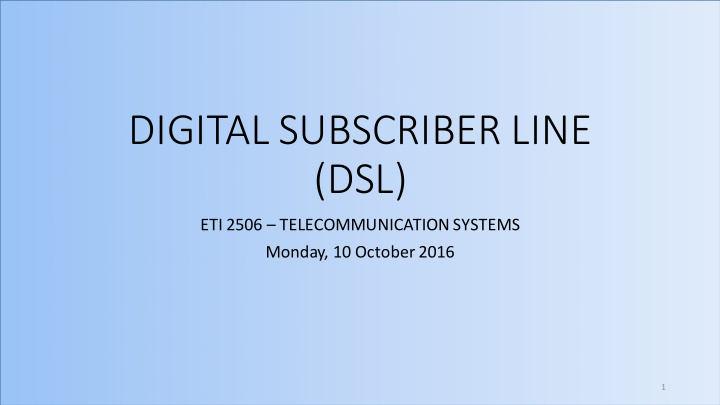



DIGITAL SUBSCRIBER LINE (DSL) ETI 2506 – TELECOMMUNICATION SYSTEMS Monday, 10 October 2016 1
COURSE OUTLINE (5) 2
DSL DEFINED 1. Digital Subscriber Line (DSL)refers to a group of technologies that utilize the unused bandwidth in the existing copper access network to deliver high-speed data services from the distribution center (or central office) to the end user. 2. DSL technology is attractive because it requires little to no upgrading of the existing copper infrastructure. 3
ADSL 2+ CAN DELIVER DOWNLOAD SPEED ON UP TO 12 MHZ 4
TYPICAL DSL CONFIGURATION 5
REASONS FOR DSL 1. The local loop connecting the telephone exchange to most subscribers has the capability of carrying frequencies well beyond the 3.4 kHz upper limit of POTS. 2. Depending on the length and quality of the loop, the upper limit can be tens of megahertz. 3. DSL takes advantage of this unused bandwidth of the local loop by creating multiple 4,312.5 Hz wide channels. 4. Allocation of channels continues at higher and higher frequencies (up to 1.1 MHz for ADSL) until additional channels are deemed unusable. 5. Each channel is evaluated for usability in much the same way an analog modem would on a traditional telephone connection. 6. More usable channels equates to more available bandwidth, which is why distance and line quality are a factor, i.e the higher frequencies used by DSL travel only short distances. 7. The pool of usable channels is then split into two different frequency bands for upstream and downstream traffic, based on a preconfigured ratio. This segregation reduces interference. 8. Once the channel groups have been established, the individual channels are bonded into a pair of virtual circuits, one in each direction. 9. Like analog modems, DSL transceivers constantly monitor the quality of each channel and will add or remove them from service depending on whether they are usable. 6
ASYMMETRIC DIGITAL SUBSCRIBER LINE (ADSL) The most commonly used DSL system is the Asymmetric Digital Subscriber Line which comes in the following standards: • ANSI T1.413-1998 • G.992.1 = 8.1/0.8 Mbps (down/up) • G.992.2 = 1.5/0.5 • G.992.5 = ADSL2plus up to 24 Mbps at 5,000 feet (Jan 2003) • ADSL4 = 52 Mbps proposed quad spectrum (ADSL2++) 7
ANSI T1.413-1998 (DOWN STREAM) 1. ANSI T1.413-1998 was the first ADSL standard and was developed by the American National Standards Institute (ANSI) Telecommunication Committee and labelled “ Asymmetric Digital Subscriber Line (ADSL) Metallic Interface. ” 2. The standard divides the useful bandwidth of the standard two-wire copper medium used in the PSTN, which is 0 to 1,104kHz, into 256 separate 4.3125kHz wide bins called sub-carriers (224 down-stream and 32 up stream) . 3. A sub-carrier is associated with a discrete frequency, or tone, indicated by 4.3125kHz x n, where n = 1 to 256, and is essentially a single distinct data channel. 8
ALLOCATION OF FREQUENCY BAND 1. The frequency layout can be summarised as: a) 300 Hz - 4 kHz, voice. b) 4 – 26 kHz, unused guard band. c) 26 – 138 kHz, 25 upstream bins (7-31). d) 138 – 1104 kHz, 224 downstream bins (32-255) 2. Typically, a few bins around 31-32 are not used in order to prevent interference between upstream and downstream bins either side of 138 kHz. 3. The unused bins constitute a guard band to be chosen by each Digital Subscriber Line Access Multiplexer (DSLAM) manufacturer. 9
DSL ANSI T1.413-1998 DOWN STREAM 4. Sub-carrier 256 and sub-carrier 64 are not available for user data, thus limiting the total number of available downstream sub-carriers to 254. 5. Each carrier supports 15 bit frame size which are transmitted at 4,000 frames/second. 6. The maximum down link data rate is therefore 15 X 4,000 X 254 = 15.24 Mb/s. 10
DSL ANSI T1.413-1998 (UP STREAM) 7. In the upstream direction, a maximum of 32 carriers are used to modulate data. 8. Sub-carrier 32 and sub-carrier 16 are not used to carry user data. 9. Each carrier supports 15 bit frame size which are transmitted at 4,000 frames/second. 10. The maximum up-stream data rate is therefore 30 X 15 X 4,000 = 1.8 Mb/s. 11
TYPICAL ADSL SET-UP 1. The right side shows a DSLAM residing in the telephone company's central office. 2. The left side shows the customer DSL Access Multiplexer premises equipment with an optional router. 3. This router manages a local area network (LAN) off of which are connected some number of PCs. 4. With many service providers, the customer may opt for a modem which contains a wireless router. 12
TYPICAL ADSL SET-UP WiFi DSLAM ROUTER Transmitter FIXED PHONE Computer 1 Ethernet LAN Computer 2 13
VDSL DEFINITION 1. Very-high-bit-rate digital subscriber line (VDSL or VHDSL) is a digital subscriber line (DSL) technology providing data transmission faster than ADSL over a single flat untwisted or twisted pair of copper wires (up to 52 Mbit/s downstream and 16 Mbit/s upstream). 2. VHDSL on coaxial cable can achieve speeds of up to 85 Mbit/s down- and upstream) using the frequency band from 25 kHz to 12 MHz. 3. These rates mean that VDSL is capable of supporting applications such as high-definition television, as well as telephone services (voice over IP) and general Internet access, over a single connection. 4. VDSL is deployed over existing wiring used for analog telephone service and lower-speed DSL connections. 14
VDSL STANDARDS 1. This standard was approved by ITU in November 2001. 2. Second-generation systems (VDSL2; ITU-T G.993.2 approved in February 2006) provides data rates exceeding 100 Mbit/s simultaneously in both the upstream and downstream directions. 3. The maximum available bit rate is achieved at a range of about 300 meters; performance degrades as the copper cable attenuation increases with increasing cable length. STANDARD COMMON APPROVED VERSION DOWNSTREAM RATE UPSTREAM RATE NAME NAME IN VDSL ITU G.993.1 VDSL 55 Mbit/s 3Mbit/s 2004-06-13 VDSL2 ITU G.993.2 VDSL2 100 Mbit/s 100 Mbit/s 2006-02-17 15
Recommend
More recommend